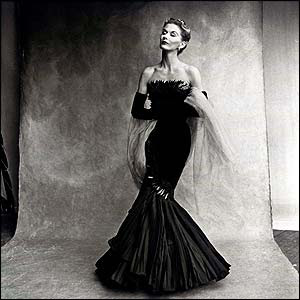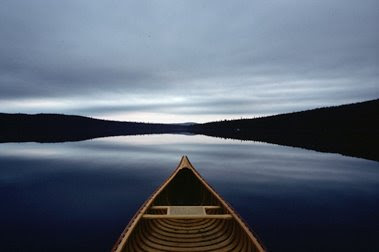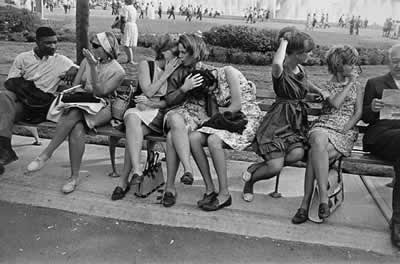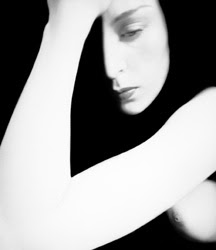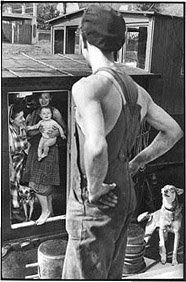Comment: I do agree with his opinion from this interview, especially those in bold. I personally think the best way to capture human portrait is when they are in its original form and nature.
-------------------------------------------------------------------------------------
David Bailey: still snapping away at 71
David Bailey is fed up with fashion photography. “D’you know,” he rages, “any model over the age of 23 has to be touched up these days. Twenty-three? It’s f***ing ridiculous but that’s what you have to do for American Vogue and it’s getting to be the same over here.”
British fashion photography has lost its edge, he reckons. “They want shoots that look like a shop window in Knightsbridge. They always have the same kind of dead-looking girls. It isn’t interesting and the girls aren’t interesting. Because they aren’t girls. They’re androids. Airbrushed and cleaned up and not real. And you can’t tell any more who took the photographs. You used to be able to tell; there was character to the pictures. You could tell this was a [Helmut] Newton or that was a Beaton or a Horst or whatever. A Bailey woman has a distinct look. A Bailey woman is a real woman of flesh and blood and sex.”
Spread on the floor of his Clerkenwell studio, among myriad portraits of Kate Moss, Mick Jagger, Damien Hirst and an anonymous vagina, is a recent, giant, black and white nude photograph of his fourth wife Catherine – fourth wife of 24 years, mind you, and we can perhaps assume his last. She is 48 years old, has had three children with Bailey and still, with the help of an artfully placed silk scarf, looks fabulous. “This hasn’t been touched up. She’s real. She’s sexy. You see, with Botox and touching up and all that fake stuff you don’t get a real woman. I prefer my women to be real,” he says with a wicked chuckle.
David Bailey, CBE, is 71 and still has all the instincts of the enfant terrible who once asked the managing director of Vogue to move his Humber so that he could park his Rolls-Royce. He may no longer slip to the floor in his jeans to zoom in on his beautiful models, as Thomas, the character played by David Hemmings and based on Bailey, did in Antonioni’s 1966 film, Blow-Up. But he is still stirring in different ways.
This autumn he is doing a sculpture show at the Pangolin London gallery in Kings Place, near King’s Cross — sculptures of heads with big long tongues lolling out of their mouths. “I’ve always had a thing about tongues because the tongue is a kind of sexual appendage, really, and it doesn’t wear a dress or a pair of trousers. Everyone sticks their tongue out. You taste with your tongue, you have sex with your tongue, you stick your tongue down somebody’s throat. And the Queen goes to New Zealand and the Maoris go ‘lulululu’ at her with their great big tongues, and she says ‘Yes. Charming’.” He laughs uproariously. “So I thought I’d do a whole lot of different heads with tongues sticking out.”
He is also doing a photographic campaign for Nokia to promote its N86 camera phone. The night before we meet he has been out pacing the streets, using the tiny camera phone to photograph people who work at night. “We photographed people working in bakeries, at the meat market, a paramedic, that kind of thing.”
When he got home at 6am he settled down, rather surprisingly, to read a bit of Samuel Pepys. “God! He was a bit of a scallywag, wasn’t he? He did everyone. I love the way he did it and the way he describes it: ‘A charging stallion invaded her private quarters ... he inserted his fingers into her thing’ — her thing! — ‘which exceedingly excited her . . .’ ” Bailey roars with laughter. I point out that he once said that he had slept with 350 models. “It was a joke! Actually I said 365 models, which is really not that many. It’s only one a day for a year.”
In spite of having had just three hours’ sleep, Bailey is on cracking form, showing no signs of slowing down. He sits in a saggy old armchair, dressed in a black T-shirt, an old red shirt and his usual jeans. No longer the virile emblem of the Swinging Sixties, he is stout, wheezy and encumbered by age but his manner has not changed and it is just as difficult to do justice in a family newspaper to the richness of his speech. Somehow, at 71, he is still attractive and irrepressibly flirtatious.
He still works for Condé Nast, primarily for Vogue, Vanity Fair and for GQ, for whom he has just finished a “Men of Power” portrait series — and a series of extremely sexy portraits of his wife, both coming out later this year. He has published four books in the past three years, with six more coming shortly. This autumn his work will be in a Polaroids show at Atlas Gallery in the West End, and in the National Portrait Gallery’s 1960s photography show; all that on top of his own sculpture show at Pangolin London. A settled private life has in no way slowed his productivity.
He has, as he puts it, had six wives and three marriages: the first was to Rosemary Bramble, a Clapham typist whom he married in 1960 and who has slightly been airbrushed out of the Bailey legend. The next year he began a four-year relationship with the model Jean Shrimpton, who was superseded by the actress Catherine Deneuve, whom he reportedly married “on a whim”. Then in 1968 he began living with Penelope Tree, a US model. In 1975 he married the model Marie Helvin, then 11 years later he married another model, Catherine Dyer, 23 years his junior, with whom he has been ever since.
Talk about complicated. How do they feel about each other? “They’re all friends. I still see them all on and off, perhaps more Marie and Penelope than the others.”
Bailey has three children with Catherine: Paloma, 24; Fenton, 21; and Sascha, 15. Paloma has been working in Bailey’s studio this summer. “Sascha is about to go and work for [the business mogul]] Philip Green for work experience. That’ll knock him into f***ing shape. Fenton is taking pictures. He did a record cover the other day — it wasn’t bad. But he’s not very motivated... I had my own tailoring business at 14. In those days, if you didn’t work you didn’t eat.”
The pressure to earn has never left him. Bailey doesn’t take holidays., or even a weekend off. “I can’t. The rates on this place and the room over the road come to £38,000 a year. I’m a pauper compared with old golden balls Damien [Hirst].”
Bailey is no pauper. As well as his commercial work and the Condé Nast commissions, his prints sell for tens of thousands. “The market has come up again in the past couple of months, I’m glad to say.” He has just done a book with Damien Hirst, 8 Minutes. There is a two-volume book on India in the pipeline, and a three-volume book on the East End. You sense that Bailey knows that if he were to slow down, he would stop, so the pace remains relentless.
It was ever thus. Born in Leytonstone in the East End, in the next street to where one of his heroes, Alfred Hitchcock, was born, he began his working life at 14, was called up for National Service at 18 and joined the RAF, which dispatched him to Singapore, where he was trained in parachuting and jungle rescue. “I learnt a lot very quickly. All I’d known as a boy was the cinema. I was dyslexic and caned for it at school. I left school with no qualifications. I didn’t know there were museums or art colleges. I also didn’t know about snobbery because no one was in a position to be snobbish in the East End when I was growing up — I certainly learnt about snobbery in the air force, though, so I was quite well prepared for Vogue in a funny way.”
Leaving the RAF at the tail end of the 1950s, he got a job as an apprentice with John French, the fashion photographer. “Yes, he hired me because of what I was wearing. Obviously he was gay. If it hadn’t been for two gay men [the other was John Parsons, art director of Vogue, who hired Bailey in 1960] I’d still be driving a bus.”
Instead, Bailey went on to become the most successful of what the society photographer Norman Parkinson called “the Black Trinity”, the glamorous, working-class, hardworking and heterosexual photographic trio of Bailey, Terence Donovan and Brian Duffy.
Bailey quickly stirred up the fashion department at Vogue, where, in the early Sixties, the implicit sexuality of his photographs was at odds with the prevailing style of tight, well-behaved polish. The place, he recalls, was run like a point-to-point, with women who had no visual sense “getting all hysterical over some amusing little hemline”. “They just didn’t get what I was trying to do. Fortunately I was an arrogant arsehole and I was lucky that John Parsons and [Alexander] Lieberman were there, who could see what I was doing.”
Whatever the guidelines set by fashion editors, Bailey managed to flout them, subtly or blatantly, and produced one of the most enduring bodies of fashion and beauty photography of the Sixties, Seventies and beyond. His artistic integrity intact, he also became an accomplished portrait and documentary photographer. “I always tried to make my fashion photographs look like Cole Porter songs in my mind, and my portraits more like the blues.”
Cecil Beaton, whose photographs had dominated Vogue in the Thirties, was taken aback by Bailey’s arrival in 1960. “He patted me on the head and said ‘I don’t really get this David Bailey but I guess he’s got some kind of Cockney charm’ and I thought ‘that’s funny Cecil, you silly old queen’. I remember doing a portrait of him and I asked him ‘Are you vain?’ ‘Me, vain?’ he said, sitting in a red f***ing cashmere f***ing dressing gown, with a red silk scarf against red f***ing felt wallpaper . . .”
Beaton, Parkinson, Avedon, not to say Donovan, are all gone and Duffy gave up photography years ago, but Bailey is still extraordinarily competitive. “Lots of the photographers I knew have died, and I’ve been at Condé Nast longer than anybody. ]My first photograph published in Vogue was in July 1960. It’ll be 50 years next July.” Bailey heaves himself up and goes off to edit last night’s pictures, before driving down to Devon to work on those tongues again. There’s no stopping this man.
David Bailey’s camera phone pictures go on show at The Old Dairy, Bloomsbury, London, on August 27 and 28.
